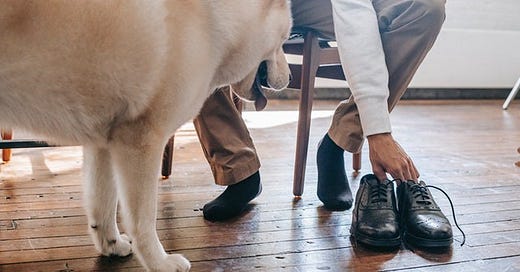
You would think that since dogs can attack your own shoes that they would be a fan of wearing their own dog boots and dog shoes, too, right? Not so much. If you follow actress Mignon (Daniella “Danni” King from Tyler Perry’s show “Sistas”) on Instagram, then you can probably recall your pup acting like this when you put those dog boots on him. But if you live in a cold-weather climate or rocky climate that can hurt a dog’s paws, he may just have to get used to it.
Snow, ice, salt and ice melt chemicals are no friends of paws. According to the American Kennel Club, “icy particles and snow can collect between his toes, and most road salts and deicers are toxic to dogs.” While he may not think you’re doing him any favors, this is one of those decisions that your dog will just have to live with — during your walks at least.
From OCD to foxtail dangers and paw massages, the way a dog and its owner treats paws can affect everything from his heart to his legs. Check out these five tips to help improve a dog’s paw health.
Recommended Read: “Five go-to tips for checking your dog's paw pads ~ Avoid painful cuts, dried pads or blistered pads on your puppy”
Recognizing lick granuloma
People aren’t the only living beings who can develop obsessive compulsive disorder (OCD). Dogs can, too, but pet owners may mistake a pet repeatedly licking or chewing at its paws as playing around.
ADVERTISEMENT ~ Amazon
As an Amazon affiliate, I earn a percentage from purchases with my referral links. I know some consumers are choosing to boycott Amazon for its DEI removal. However, after thinking about this thoroughly, I choose to continue promoting intriguing products from small businesses, women-owned businesses and (specifically) Black-owned businesses who still feature their items on Amazon. All five of my Substack publications now include a MINIMUM of one product sold by a Black-owned business. (I have visited the seller’s official site, not just the Amazon Black-owned logo, to verify this.) If you still choose to boycott, I 100% respect that decision.
According to American Kennel Club’s Canine Health Foundation, lick granuloma is “a form of self-trauma where the dog continuously licks a small area, most commonly the paw that becomes raw and inflamed.” Boredom, compulsiveness and stress are key factors in why this may happen. But if the dog ingests something that is on its paws, this could turn into a dangerous situation. Never underestimate a dog paying too much attention to one area.

On your walk around, watch your dog and his paws
Dogs that regularly run in grass, along rocks and in fields will develop a thicker paw texture for running in rougher territories. House dogs will undoubtedly have a more difficult time with this adjustment. Weather may also affect how a dog feels while traveling. Paws shares a few dog-walking suggestions for paw health:
Spring and summer veterinary check-ups to fight off parasites (ex. fleas and ticks)
Preventing over-exercising
Walking in the shade
Taking walks before sun-up or after sundown to help avoid excess heat and hot gravel/sidewalks
Be aware of sudden limping
Be on the lookout for foxtails





